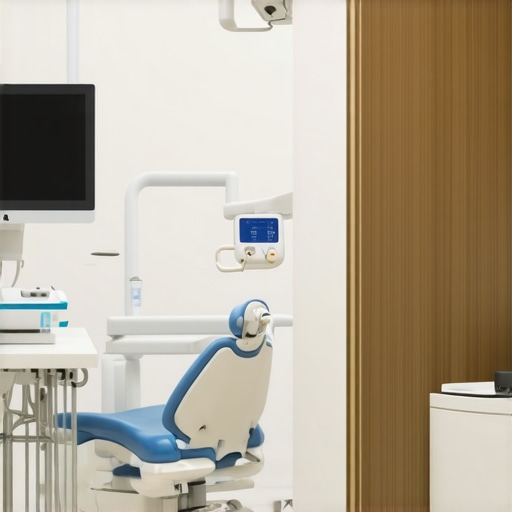Harnessing the Power of Trust in Family Dentistry: The Foundation for Long-Term Oral Health
In the evolving landscape of family dentistry, establishing unwavering trust with patients is not merely a courtesy but a strategic imperative. As professionals, we recognize that trust underpins patient compliance, reduces dental anxiety, and fosters loyalty—cornerstones for effective preventive care and aesthetic enhancements. According to recent studies published in the Journal of the American Dental Association, trust correlates strongly with patient adherence to treatment plans, especially in pediatric and geriatric populations.
Innovative Techniques for Brightening Smiles: Beyond Whitening
Brightening smiles in 2024 transcends basic teeth whitening. It involves a nuanced understanding of individual enamel chemistry, biofilm management, and the integration of minimally invasive procedures such as veneers and aligners like Invisalign. These modalities not only enhance aesthetics but also contribute to the overall health and integrity of the dentition, reflecting a holistic approach to smile design.
What Are the Key Challenges in Achieving Trust and Bright Smiles?
How Can Family Dentists Navigate Complex Patient Expectations and Technological Advances?
Balancing patient expectations with realistic outcomes requires a blend of transparent communication, advanced diagnostic tools, and personalized treatment planning. The integration of digital smile design and 3D imaging allows clinicians to set accurate expectations and visually demonstrate potential results, thereby strengthening trust. Furthermore, staying abreast of emerging technologies such as laser dentistry and biocompatible materials ensures that practitioners provide state-of-the-art care, which is fundamental for building authority and confidence in the patient-provider relationship.
To deepen your understanding of these innovations, explore our comprehensive guide on smile transformations with veneers and Invisalign.
Enhancing Patient Engagement Through Education and Transparency
Empowering patients with knowledge about preventive strategies, such as effective oral hygiene routines and dietary counseling, enhances trust and encourages proactive participation. Regular updates about new treatments and technological advancements can be disseminated through patient portals or educational seminars, positioning your practice as a leader in family-centered dental care.
In conclusion, the convergence of trust-building strategies and aesthetic innovations forms the bedrock of successful family dentistry practices in 2024. Implementing these advanced insights not only elevates patient satisfaction but also promotes sustained oral health and confidence across generations.
For further professional insights, consider contributing your experiences and strategies by visiting our contact page.
Innovative Diagnostic Tools: The Future of Personalized Smile Care
In the pursuit of excellence in family dentistry, embracing cutting-edge diagnostic technology is crucial. Digital impressions, 3D imaging, and intraoral scanners enable clinicians to craft highly personalized treatment plans, ensuring predictable outcomes and fostering patient confidence. These tools also allow for precise visualization of potential results, which enhances transparency and trust—cornerstones for long-term patient relationships. According to a study published in the Journal of the American Dental Association, integrating advanced diagnostics correlates strongly with improved patient satisfaction and adherence to treatment plans.
The Role of AI and Teledentistry in Modern Family Dentistry
Artificial Intelligence (AI) and teledentistry are revolutionizing access and quality of care. AI-powered algorithms assist in early detection of dental anomalies and caries, allowing for preventive interventions that preserve natural dentition. Meanwhile, teledentistry expands reach, especially for busy families or those in remote areas, providing consultation, follow-up, and education remotely. Incorporating these technologies not only demonstrates a commitment to innovation but also builds authority in the community. Explore our detailed article on transforming smiles with advanced cosmetic and preventive care.
How Can Family Dentists Leverage Technology to Overcome Common Patient Barriers and Elevate Trust?
Overcoming barriers such as fear, misinformation, and accessibility challenges requires a strategic blend of transparency, empathetic communication, and technological integration. Utilizing digital smile design and virtual consultations allows patients to visualize outcomes beforehand, reducing anxiety and fostering trust. Moreover, providing educational content through patient portals enhances understanding and engagement. For instance, sharing success stories and technological insights can position your practice as a leader in innovative family dental care. To implement these strategies effectively, consider reading more about trusted tips for enhancing family smiles and trust.
Creating a Culture of Continuous Learning and Adaptation
Staying at the forefront of dental innovation involves ongoing education, attending conferences, and participating in peer networks. As new materials, techniques, and technologies emerge, adapting your practice and training staff ensures you provide the most current and effective care. This commitment not only improves clinical outcomes but also demonstrates expertise and reliability to your patients. Additionally, fostering a culture of transparency, where patient feedback is valued and integrated into practice improvements, further strengthens trust and loyalty. For insights into the latest educational resources, visit top cosmetic enhancements and educational tips.
The Power of Holistic Smile Design in Family Dentistry
Holistic smile design considers not just aesthetics but also function, health, and patient lifestyle. Integrating orthodontics like Invisalign, veneers, whitening, and periodontal health creates a comprehensive approach that addresses underlying issues and enhances overall well-being. This strategy aligns with current evidence emphasizing patient-centered care that respects individual needs and circumstances. As you adopt a holistic mindset, remember that effective communication and education are key to aligning patient expectations with realistic outcomes. For a deeper dive into holistic smile design, review our guide on ultimate smile transformation tips.
< >
>
Implementing Cutting-Edge Digital Tools for Enhanced Patient Confidence and Customization
In today’s competitive dental landscape, harnessing sophisticated digital technologies elevates the standard of care while reinforcing trust. Utilizing intraoral scanners and 3D imaging not only streamlines workflows but also provides patients with clear, visual representations of their treatment options. This transparency cultivates confidence, aligning expectations with achievable outcomes. According to a comprehensive review in the Journal of the American Dental Association, practices that integrate digital diagnostics report higher patient satisfaction and adherence rates, underscoring their importance in modern family dentistry.
Leveraging AI and Machine Learning for Proactive Dental Care
Artificial Intelligence (AI) is transforming preventive dentistry by enabling early detection of caries, periodontal disease, and other anomalies before they manifest visibly. Machine learning algorithms analyze extensive datasets from patient histories and imaging to predict risk factors, allowing for tailored preventive interventions. This proactive approach not only enhances patient outcomes but also positions your practice as a leader in innovation. For example, AI-driven caries detection systems have demonstrated accuracy rates exceeding 90%, significantly reducing diagnostic errors (source: PubMed).
What are the ethical considerations and limitations of relying on AI in family dental diagnostics?
While AI offers remarkable potential, ethical issues such as data privacy, algorithmic bias, and the need for human oversight remain critical. Ensuring patient data protection complies with HIPAA standards and validating AI outputs through clinical judgment are essential steps. Moreover, transparency about AI’s role in diagnosis fosters trust, emphasizing that technology supports, rather than replaces, professional expertise. For nuanced insights into AI ethics, consult authoritative sources like the ADA’s guidelines on AI ethics.
Creating a Patient-Centric Educational Ecosystem for Long-Term Engagement
Building trust extends beyond the treatment room into ongoing education. Implementing interactive patient portals that provide personalized educational content about oral health, treatment options, and technological advancements encourages proactive participation. Regular webinars and workshops can demystify complex procedures like laser therapy or biocompatible restorations, reducing anxiety and misinformation. Such initiatives foster a culture of transparency and continuous learning, vital for cultivating loyalty and advocacy among your patient base. As noted by the American Academy of Pediatric Dentistry, patient education significantly correlates with improved compliance and satisfaction.
Integrating Teledentistry with In-Office Care for Seamless Continuity
Teledentistry bridges geographical and logistical barriers, offering remote consultations, follow-ups, and patient education. This technology not only enhances accessibility but also demonstrates a commitment to comprehensive care, reinforcing trust in your practice. Virtual assessments using high-resolution imaging allow early intervention planning, while post-treatment telemonitoring ensures ongoing support. To maximize benefits, integrate secure, user-friendly platforms aligned with your practice workflow. Learn more about successful integration strategies from the ADA’s recent guidelines on teledentistry.
Fostering a Culture of Innovation and Continuous Improvement
Staying at the frontier of dental technology requires a strategic commitment to ongoing education, research, and adaptation. Participating in industry conferences, subscribing to peer-reviewed journals, and engaging with professional networks ensure your practice remains informed about emerging trends. Incorporating feedback mechanisms from patients about new technologies and approaches refines your service delivery, reinforcing a patient-centered ethos. As highlighted in the NIH-funded research, a culture of continuous learning directly correlates with higher trust, loyalty, and clinical excellence.
Embracing Holistic Smile Design for Personalized, Multifaceted Care
Holistic smile design integrates aesthetics, function, and health, considering patient lifestyle, habits, and systemic conditions. Combining orthodontics, periodontics, and restorative dentistry into a cohesive treatment plan addresses underlying issues and aligns with patient goals. This comprehensive approach necessitates detailed case analysis, interdisciplinary collaboration, and transparent communication to manage expectations effectively. For an in-depth exploration of holistic strategies, review our guide on holistic smile design techniques.

Leveraging Biometric Data to Tailor Dental Treatments: A New Frontier in Patient Trust
In the quest for personalized dentistry, the integration of biometric data—such as salivary diagnostics, genetic markers, and digital habit tracking—provides an unprecedented depth of insight into individual oral health profiles. This technological leap allows practitioners to craft precision treatment plans that resonate deeply with patient-specific needs, thereby significantly enhancing trust and satisfaction. As noted by the Journal of the American Dental Association, leveraging biometric insights fosters a more transparent, data-driven dialogue that reassures patients about the tailored nature of their care.
Expanding the Role of Virtual Reality in Patient Education and Anxiety Reduction
Emerging virtual reality (VR) applications are transforming patient engagement by immersing individuals in interactive simulations that demystify complex procedures such as implants or orthodontics. This immersive approach not only educates but also alleviates anxiety—an essential factor in trust-building. For example, a VR walkthrough of a root canal process can reduce procedural fear and foster a sense of familiarity and control. The adoption of VR technology signifies a strategic move toward elevating patient experience and positioning your practice as a leader in innovative, empathetic care.
How Can Family Dentists Integrate Virtual Reality Effectively to Enhance Patient Trust?
Implementing VR requires careful selection of user-friendly platforms, staff training, and personalized content development aligned with common patient concerns. Collaborating with tech developers and utilizing evidence-based visualizations ensures effectiveness. To explore comprehensive integration strategies, visit our detailed guide on VR applications in modern dental practice.
By harnessing biometric data and VR, you elevate the level of personalized care, transforming patient experiences from apprehensive visits to engaging, trust-enhancing encounters. Embrace these innovations to position your practice at the forefront of dental excellence and patient-centric service.
Implementing AI-Driven Predictive Analytics for Proactive Oral Health Management
Artificial Intelligence (AI) is increasingly utilized to analyze vast datasets, enabling predictive analytics that forecast disease progression, caries risk, and periodontal breakdown with remarkable accuracy. This proactive approach shifts the paradigm from reactive treatment to preventative mastery, fostering confidence in your expertise. According to recent research published in PubMed, AI-assisted diagnostics improve early detection rates and patient adherence, thereby strengthening trust and long-term engagement.
What Ethical and Practical Considerations Must Be Addressed When Using AI for Family Dental Care?
Addressing concerns about data privacy, algorithmic bias, and clinical oversight is paramount. Establishing transparent protocols, obtaining informed consent, and maintaining human-in-the-loop validation ensure ethical integrity. Moreover, continuous staff education on AI limitations and benefits fortifies patient-provider trust, aligning technological advancements with ethical standards. For a comprehensive overview, see the ADA’s guidelines on AI ethics in dentistry.
By integrating biometric insights, VR, and AI-driven analytics, your practice can redefine patient trust, delivering highly personalized, innovative care that meets the demands of modern families and elevates your professional reputation to new heights.
Expert Insights & Advanced Considerations
1. Emphasize the Integration of Biometric Data for Personalized Care
Leveraging biometric data such as salivary diagnostics and genetic markers enables highly tailored treatment plans, significantly enhancing patient trust and satisfaction. This approach fosters a data-driven dialogue that reassures patients about the precision of their care, positioning your practice at the forefront of dental innovation.
2. Incorporate Virtual Reality for Patient Education and Anxiety Reduction
Emerging VR applications create immersive experiences that demystify complex procedures, reducing anxiety and improving engagement. Implementing VR walkthroughs of treatments like implants or orthodontics can transform patient perceptions and foster deeper trust in your expertise.
3. Adopt AI and Predictive Analytics for Proactive Oral Health Management
AI-driven diagnostics and predictive analytics enable early detection of dental issues, allowing for preventative interventions. This proactive approach demonstrates advanced competency and builds confidence in your clinical judgment.
4. Commit to Continuous Learning and Technological Adoption
Stay updated through industry conferences, peer-reviewed journals, and professional networks. Fostering a culture of innovation and transparency ensures your practice remains a leader in family dentistry, reinforcing long-term trust and loyalty.
5. Embrace Holistic Smile Design for Multifaceted Patient Care
Integrate aesthetics, function, and health into comprehensive treatment plans. This patient-centered, interdisciplinary approach addresses underlying issues and aligns with evolving standards of personalized care, elevating your practice’s authority.
Curated Expert Resources
- Journal of the American Dental Association: A leading resource for the latest research, especially in diagnostics, AI, and patient management strategies, providing evidence-based insights.
- ADA Guidelines on AI and Teledentistry: Authoritative standards ensuring ethical and effective integration of emerging technologies into practice.
- NIH-funded Research Publications: Cutting-edge studies on predictive analytics and biometric data, supporting data-driven decision-making.
- Professional Conferences & Peer Networks: Platforms for continuous education, technology demonstrations, and peer insights fostering a culture of innovation.
Final Expert Perspective
In the realm of family dentistry, building trust through technological mastery and personalized care is paramount. Embracing advanced tools like biometric data, VR, and AI not only elevates your clinical capabilities but also transforms patient relationships, fostering confidence and loyalty. As we move into 2024, the integration of these innovative strategies signifies a commitment to excellence that resonates deeply with modern families seeking trustworthy, comprehensive dental care. To deepen your expertise, explore our detailed guides and participate actively in professional networks—your next breakthrough in trust and innovation awaits.

